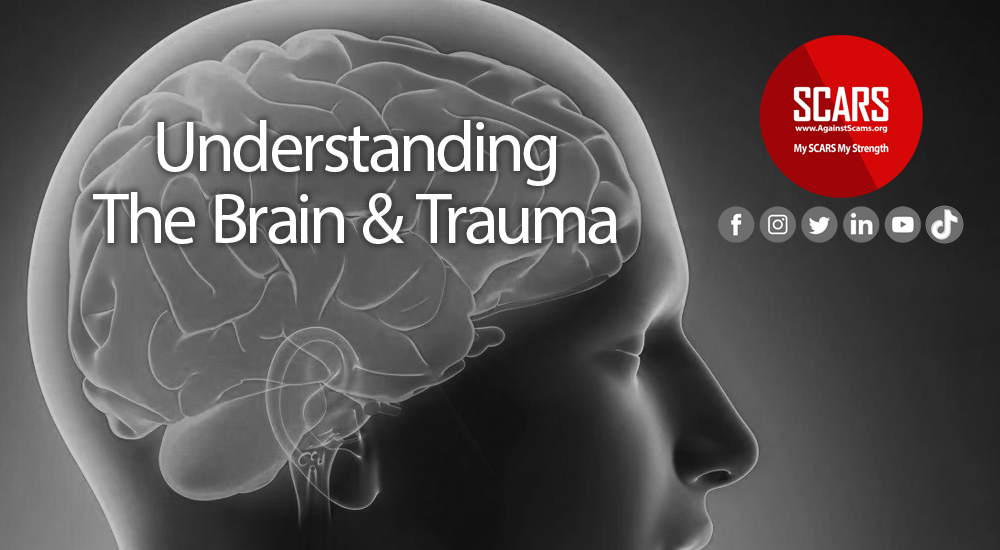Really Understanding Your Anger!
Scam Victim Anger Works Against Recovery
A Full Third Of Scam Victims Lose Themselves To Anger After The Discovery
Anger is a normal part of the grief cycle but it easily gains control and prevents a victim’s ability to move forward
How Anger Affects Your Brain and Body
Anger Can Be A Challenging Emotion To Work Through
Sometimes our anger can be frightening. Or, maybe we consider it inappropriate to even feel this way at all. Not only that, when anger is misdirected, it often leads to poor choices, damaged relationships, and even violence.
We see this in about one-third (1/3) of scam victims. It leads to vigilantism and many other bad, sometimes delusional choices. It can cause rejection of assistance from professionals, and gravitation towards other angry individuals. It can block emotional recovery and re-integration with family and friends after the discovery of a scam, especially when shame is a significant component.
But What’s Really Going On In The Brain And Body When Anger Is Triggered?
HERE IS A WAY TO VISUALIZE THIS:
In The Heat Of Anger, We Often Don’t Use Our Best Judgment
We may say and do things we later regret or lose track of what we’re arguing about. Anger affects all of our actions and decision making,
Why Is That?
It has to do with CORTISOL.
Anger can spark an overload of cortisol in the brain, and this can lead to numerous problems.
Where Does The Cortisol Come From In The First Place?
WHEN THERE’S TOO MUCH CORTISOL IN THE BRAIN …
Anger Is An Important And Sometimes Necessary Emotion
But All Too Often, Anger Can Quickly Escalate And Become Destructive Once It’s Been Triggered
Uncontrollable anger can often create problems in relationships both at home and in the workplace. But beyond that, it can have devastating physical consequences. It also leads to terrible decision-making and potentially delusional behavior.
How And Where Does Anger Impact The Body?
HOW ANGER AFFECTS YOUR BRAIN AND BODY
Information & Infographics courtesy of the National Institute for the Clinical Application of Behavioral Medicine • Copyright Acknowledged, Used With Permission of the Author NICABM.com
More Information About CORTISOL:
- https://www.webmd.com/a-to-z-guides/what-is-cortisol
- https://www.yourhormones.info/hormones/cortisol/
- https://www.mayoclinic.org/healthy-lifestyle/stress-management/in-depth/stress/art-20046037
- https://www.healthline.com/health/high-cortisol-symptoms
- https://www.healthline.com/nutrition/ways-to-lower-cortisol
A Practical Skill for Defusing Anger
When Tempers Flare And Rage Ensues, Your Relationships Suffer As Does Your Ability To Follow The Path Of Recovery!
The stress levels skyrocket, and reactivity simply takes over.
So how can people shift out of anger once the fuse is lit?
In the video below, Marsha Linehan, Ph.D. will share a practical skill to help defuse anger before it escalates beyond control. The video is created for psychologists but can be useful for you to practice yourself.
Take a look – it’s about 2 ½ minutes.
5 Ways to Diffuse Your Anger By Dr. Tracey Marks
To better understand how to stop before you lose control, let’s look at the cycle of anger.
First You Have A Triggering Event
This would be something like feeling disrespected or used or having someone cut you off in traffic. In the case of scam victims, it is just thinking of or being reminded of your scam. This is followed by negative thoughts. These are automatic thoughts that pop into your mind right after the triggering event. Then you have an emotional response to your thought, even if your thought isn’t rational.
Physical Symptoms
The next step in the cycle is the physical symptoms. Like a racing heart, or sweaty palms, or even tense muscles and jaw clenching. Then you have the behavioral response of yelling, cursing and arguing, or maybe even crying.
So with this cycle, you have things going on in your head that lead to behaviors. There are different places in this cycle you can change to address anger. This video is focused on the behavioral response.
Diffusing Techniques
Technique 1
Practice taking 3 deep breaths before you respond. This gives you the chance to resist lashing out automatically. Many times the anger response is impulsive and if you had been able to wait even 5 seconds, you may have had the control to hold back on saying something hurtful that you can’t take back.
Technique 2
Develop canned responses to controversial topics. If you’re always around people who like getting into political discussions and their views are opposite of yours, you want to already know what to say to shut the conversation down or make it clear that you have no comment. Prepare a couple of statements you can use for any topic or situation that you know triggers you. If someone repeatedly tries to engage you in the conversation or activity that you’re avoiding, use the broken record technique where you give the same response. You don’t need to craft another response, so they get it this time. Saying the same thing in the same tone sends a stronger message that you mean what you said.
Technique 3
Develop statements that de-escalate the situation before you get too angry. These would be statements like I need to take a break I need a time out – we can talk later Or the classic, maybe we need to agree to disagree on this
These are canned statements similar to the no comment statements, but the purpose of these statements is to stop a conflict that you have already participated in but you recognize it’s getting too heated for you and you’re about to blow. This is where it is helpful to know what your physical symptoms are when you start to get angry or rageful. This is step 4 in the cycle of anger. Do you start sweating? Does your chest get warm? Knowing this about yourself can help you recognize when you are going down the path to rage and know when to use this technique.
Technique 4
Stop and observe your anger. Examine it as if you’re another person in the room looking at you. What do you look like? Do you appear intensely angry because you’re throwing things? Or do you seem snippy and hot-headed? Are you talking loudly or brooding in your head? By disengaging from your anger and actually observing it in a mindful way, you take the energy out of it. This gives you time to avoid lashing out.
Technique 5
Use diversions. Let’s say you remove yourself from the situation, by using the third technique of shutting things down with an I need a time out statement. Do something to distract yourself like listening to music, taking a brief walk, or even coloring. Coloring complex drawings is a popular stress-reduction technique.
TAGS: SCARS, Psychology of Scams, Anger, Rage, Cortisol, Hormones, Infographic, Anger Management, Anger Control, Scam Victim Recovery
PLEASE SHARE OUR ARTICLES WITH YOUR FRIENDS & FAMILY
HELP OTHERS STAY SAFE ONLINE – YOUR KNOWLEDGE CAN MAKE THE DIFFERENCE!
THE NEXT VICTIM MIGHT BE YOUR OWN FAMILY MEMBER OR BEST FRIEND!
By the SCARS™ Editorial Team
Society of Citizens Against Relationship Scams Inc.
A Worldwide Crime Victims Assistance & Crime Prevention Nonprofit Organization Headquartered In Miami Florida USA & Monterrey NL Mexico, with Partners In More Than 60 Countries
To Learn More, Volunteer, or Donate Visit: www.AgainstScams.org
Contact Us: Contact@AgainstScams.org
-/ 30 /-
What do you think about this?
Please share your thoughts in a comment below!
Article Rating
Table of Contents
- A Full Third Of Scam Victims Lose Themselves To Anger After The Discovery
- Anger Can Be A Challenging Emotion To Work Through
- HERE IS A WAY TO VISUALIZE THIS:
- Why Is That?
- WHEN THERE’S TOO MUCH CORTISOL IN THE BRAIN …
- But All Too Often, Anger Can Quickly Escalate And Become Destructive Once It’s Been Triggered
- HOW ANGER AFFECTS YOUR BRAIN AND BODY
- When Tempers Flare And Rage Ensues, Your Relationships Suffer As Does Your Ability To Follow The Path Of Recovery!
- First You Have A Triggering Event
- Physical Symptoms
- Technique 1
- Technique 2
- Technique 3
- Technique 4
- Technique 5
- PLEASE SHARE OUR ARTICLES WITH YOUR FRIENDS & FAMILY
- By the SCARS™ Editorial Team
Society of Citizens Against Relationship Scams Inc. - The Issue Of Race In Scam Reporting
Click Here To Learn More!
RATE THIS ARTICLE?
LEAVE A COMMENT?
Thank you for your comment. You may receive an email to follow up. We never share your data with marketers.
Recent Comments
On Other Articles
- on Dating Scammers Paradise: Ivory Coast: “The Ivory Coast romance scam is still going on. It seems that local authorities don’t handle the issue effectively!” Dec 10, 02:17
- on The SCARS Institute Top 50 Celebrity Impersonation Scams – 2025: “Thank you – we will.” Dec 7, 11:41
- on The SCARS Institute Top 50 Celebrity Impersonation Scams – 2025: “You should add Sean Bean to your list of Celebrities. This one is very good, and persistent. He will be…” Dec 2, 12:07
- on How You Think & Talk About Your Scam Affects Your Recovery: “I have hung on to the scams for far too long. With the intervention of an all-merciful God, I have…” Nov 6, 22:13
- on Disengaging From A Fake Scam Relationship: “Taci, you may want to join our new support community at www.SCARScommunity.org” Nov 6, 03:01
- on Disengaging From A Fake Scam Relationship: “This particular article helped me discover the many things I did wrong the first time I was scammed. I should…” Nov 5, 22:49
- on About the SCARS RomanceScamsNOW.com Website – 24 Years Published: “It was unavailable for a few days, but it is available again. If he would be interested, he is welcome…” Nov 5, 00:59
- on About the SCARS RomanceScamsNOW.com Website – 24 Years Published: “My husband has been scammed and your classes have been helping him but now he can’t seem to access them.…” Oct 26, 14:57
- on Talia Shepard – Impersonation Victim – Stolen Photos – 2024: “Hi, I’m Patrick from Belgium and I found this site by chance, so I just got to know it, and…” Oct 17, 23:46
- on Talia Shepard – Impersonation Victim – Stolen Photos – 2024: “Hallo ik ben Patrick uit Belgie en het is in verband over PayPal. Ik heb het dit jaar spijtig genoeg…” Oct 17, 23:08
ARTICLE META
Important Information for New Scam Victims
- Please visit www.ScamVictimsSupport.org – a SCARS Website for New Scam Victims & Sextortion Victims
- Enroll in FREE SCARS Scam Survivor’s School now at www.SCARSeducation.org
- Please visit www.ScamPsychology.org – to more fully understand the psychological concepts involved in scams and scam victim recovery
If you are looking for local trauma counselors please visit counseling.AgainstScams.org or join SCARS for our counseling/therapy benefit: membership.AgainstScams.org
If you need to speak with someone now, you can dial 988 or find phone numbers for crisis hotlines all around the world here: www.opencounseling.com/suicide-hotlines
A Note About Labeling!
We often use the term ‘scam victim’ in our articles, but this is a convenience to help those searching for information in search engines like Google. It is just a convenience and has no deeper meaning. If you have come through such an experience, YOU are a Survivor! It was not your fault. You are not alone! Axios!
A Question of Trust
At the SCARS Institute, we invite you to do your own research on the topics we speak about and publish, Our team investigates the subject being discussed, especially when it comes to understanding the scam victims-survivors experience. You can do Google searches but in many cases, you will have to wade through scientific papers and studies. However, remember that biases and perspectives matter and influence the outcome. Regardless, we encourage you to explore these topics as thoroughly as you can for your own awareness.
Statement About Victim Blaming
Some of our articles discuss various aspects of victims. This is both about better understanding victims (the science of victimology) and their behaviors and psychology. This helps us to educate victims/survivors about why these crimes happened and to not blame themselves, better develop recovery programs, and to help victims avoid scams in the future. At times this may sound like blaming the victim, but it does not blame scam victims, we are simply explaining the hows and whys of the experience victims have.
These articles, about the Psychology of Scams or Victim Psychology – meaning that all humans have psychological or cognitive characteristics in common that can either be exploited or work against us – help us all to understand the unique challenges victims face before, during, and after scams, fraud, or cybercrimes. These sometimes talk about some of the vulnerabilities the scammers exploit. Victims rarely have control of them or are even aware of them, until something like a scam happens and then they can learn how their mind works and how to overcome these mechanisms.
Articles like these help victims and others understand these processes and how to help prevent them from being exploited again or to help them recover more easily by understanding their post-scam behaviors. Learn more about the Psychology of Scams at www.ScamPsychology.org
Psychology Disclaimer:
All articles about psychology and the human brain on this website are for information & education only
The information provided in this article is intended for educational and self-help purposes only and should not be construed as a substitute for professional therapy or counseling.
While any self-help techniques outlined herein may be beneficial for scam victims seeking to recover from their experience and move towards recovery, it is important to consult with a qualified mental health professional before initiating any course of action. Each individual’s experience and needs are unique, and what works for one person may not be suitable for another.
Additionally, any approach may not be appropriate for individuals with certain pre-existing mental health conditions or trauma histories. It is advisable to seek guidance from a licensed therapist or counselor who can provide personalized support, guidance, and treatment tailored to your specific needs.
If you are experiencing significant distress or emotional difficulties related to a scam or other traumatic event, please consult your doctor or mental health provider for appropriate care and support.
Also read our SCARS Institute Statement about Professional Care for Scam Victims – click here to go to our ScamsNOW.com website.


![Really Understanding Your Anger [INFOGRAPHIC][VIDEOS] boycott ghana Really Understanding Your Anger [INFOGRAPHIC][VIDEOS] boycott ghana](https://romancescamsnow.com/wp-content/uploads/2021/03/boycott-ghana.png)
![Really Understanding Your Anger [INFOGRAPHIC][VIDEOS] guilt vs shame understanding Understanding Guilt vs Shame - Scam Victim Psychology - A SCARS Series on RomanceScamsNOW.com](https://romancescamsnow.com/wp-content/uploads/2021/03/guilt-vs-shame-understanding.png)
![Really Understanding Your Anger [INFOGRAPHIC][VIDEOS] really understanding your anger Really Understanding Your Anger [INFOGRAPHIC][VIDEOS] really understanding your anger](https://romancescamsnow.com/wp-content/uploads/2021/03/really-understanding-your-anger.png)
![Really Understanding Your Anger [INFOGRAPHIC][VIDEOS] portal banner SCARS Institute Scam Survivor's Community portal banner](https://romancescamsnow.com/wp-content/uploads/2025/11/portal-banner.png)


![Really Understanding Your Anger [INFOGRAPHIC][VIDEOS] nicabm infog anger part1 optimized1 scaled NICABM-InfoG-Anger-Part1-optimized[1]](https://romancescamsnow.com/wp-content/uploads/2021/03/nicabm-infog-anger-part1-optimized1-scaled.jpg)
![Really Understanding Your Anger [INFOGRAPHIC][VIDEOS] nicabm infog anger part2 optimized1 scaled NICABM-InfoG-Anger-Part2-optimized[1]](https://romancescamsnow.com/wp-content/uploads/2021/03/nicabm-infog-anger-part2-optimized1-scaled.jpg)
![Really Understanding Your Anger [INFOGRAPHIC][VIDEOS] nicabm infog anger part3 optimized1 scaled NICABM-InfoG-Anger-Part3-optimized[1]](https://romancescamsnow.com/wp-content/uploads/2021/03/nicabm-infog-anger-part3-optimized1-scaled.jpg)
![Really Understanding Your Anger [INFOGRAPHIC][VIDEOS] 148123742 10158247777061314 8380904067722412197 o How NAger Works](https://romancescamsnow.com/wp-content/uploads/2021/03/148123742-10158247777061314-8380904067722412197-o.jpg)
![Really Understanding Your Anger [INFOGRAPHIC][VIDEOS] your greatest enemy Anger Is Your Greatest Enemy!](https://romancescamsnow.com/wp-content/uploads/2021/03/your-greatest-enemy.png)
![Really Understanding Your Anger [INFOGRAPHIC][VIDEOS] scars ball 1200x1200 print colors SCARS the Society of Citizens Against Relationship Scams Incorporated](https://romancescamsnow.com/wp-content/uploads/2020/11/scars-ball-1200x1200-print-colors.png)


![Don't Call Scammers Names - You Are Personalizing It And Making It Harder To Recover - Please Just Stop It! - 2024 [UPDATED] Dont Call Scammers Names Don't Call Scammers Names - You Are Personalizing It And Making It Harder To Recover - Please Just Stop It! - 2024 [UPDATED] - on SCARS RomanceScamsNOW.com](https://romancescamsnow.com/wp-content/uploads/2018/09/Dont-Call-Scammers-Names.png)



![Really Understanding Your Anger [INFOGRAPHIC][VIDEOS] SCARS CDN REPORT SCAMEMRS HERE e1697414569935 SCARS-CDN-REPORT-SCAMEMRS-HERE](https://romancescamsnow.com/wp-content/uploads/2018/12/SCARS-CDN-REPORT-SCAMEMRS-HERE-e1697414569935.png?_t=1697414571)
![Really Understanding Your Anger [INFOGRAPHIC][VIDEOS] NavyLogo@4x 81 U.S. & Canada Suicide Lifeline 988](https://romancescamsnow.com/wp-content/uploads/2023/06/NavyLogo@4x-81.png)

![Really Understanding Your Anger [INFOGRAPHIC][VIDEOS] niprc1.png1 150x1501 11 Really Understanding Your Anger [INFOGRAPHIC][VIDEOS] niprc1.png1 150x1501 11](https://scamsnow.com/wp-content/uploads/2025/04/niprc1.png1_-150x1501-11.webp)
It’s rare that I ever feel really angry with someone or at a life event. Growing up I had an older brother who lost his temper often and I always thought he looked really silly when he got angry. I learned a lot of what not to do watching my brother.